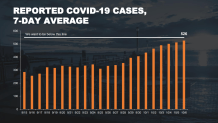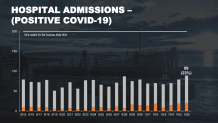What to Know
- Protests have erupted on three consecutive nights in Brooklyn's Borough Park neighborhood, one of nine in the city most affected by the latest round of COVID restrictions issued by Gov. Andrew Cuomo
- Many of the hotspots involve enclaves of ultra-Orthodox Jewish community members who protest the new mass gathering bans; nonessential businesses and schools have also been shut down
- On the other side of the spectrum, more than 400 rabbis and other Jewish religious leaders signed a statement in support of the "data-driven, life-saving measures" to prevent more COVID spread in NY
A prominent Orthodox Jewish organization based out of Queens and the Roman Catholic Diocese of Brooklyn announced separate lawsuits to halt restrictions on religious gatherings put in place by the state of New York, just as a third day of protests over the new lockdown orders got underway in Brooklyn.
Agudath Israel of America on Thursday asked for a temporary restraining order to stop the state from restricting houses of worship from strictly limiting attendance at synagogues ahead of Shmini Atzeres and Simchas Torah, religious holidays set to begin on Friday; Audath also alleges that Gov. Cuomo and his administration are unfairly targeting members of the state's Orthodox community. The Brooklyn diocese is suing on the basis that the restrictions are unconstitutional under the First Amendment right to freely exercise religion.
Rich Azzopardi, a senior advisor to the governor, responded in a statement saying "we've been sued virtually every day for every action taken. We're concentrating on reducing the virus in these hot spots and saving lives, period."
The move came just as a third night of protests got underway in the heavily Orthodox neighborhood of Borough Park, which is along the so-called "Ocean Parkway" Covid cluster in south Brooklyn. Thursday's protests were far smaller and more orderly than the two that preceded it. Those demonstrations beecame chaotic, and at least three people were attacked.
Some in that community take issue with the new limitations on crowd sizes and religious gatherings. In red zones where positivity rates are highest, there's a hard cap of 10 congregants; it's just 25 in lower-risk "orange zones." The sweeping slate of restrictions also shutters nonessential businesses and closes schools in the highest-risk neighborhoods.
U.S. & World
The day's top national and international news.
Borough Park is one of nine of those in the city. Some areas are subject to lesser restrictions, based on the color-coded system Gov. Andrew Cuomo unveiled this week.
While images of protesters burning masks in the street earlier this week may be seared into people's minds, they reflect only a subset of the Jewish community -- one that is divided even among its own members. On Thursday, the New York Jewish Agenda released a statement signed by more than 400 rabbis and other Jewish religious leaders in support of the "data-driven, life-saving measures" to prevent the spread of COVID that were newly unveiled in New York this week. Orthodox clergy members were among those who signed their names.
“We support the governor’s and mayor’s efforts to stem the spread of COVID-19 by using a data-driven, geographically based approach,” NYJA President Matt Nosanchuk said in a statement. "Today, more than 300 Rabbis and other Jewish religious leaders came together to make clear there is no higher Jewish value than saving a human life."
The other end of the spectrum has featured two nights of protesters setting fires in the streets, tossing masks into the flames and waving Trump flags in stark opposition to the latest shutdowns. Some protests have turned violent, though the NYPD has said no arrests have been made on either night thus far.
Bruce Schaff has been photographing protests since thousands took to the streets in the wake of George Floyd's death back in May. But the freelancer says none of them could compare to what he went through while trying to document demonstrations against the latest COVID-19 restrictions in New York City.
"It was absolutely insane," said Schaff, who was one of at least two men attacked while covering demonstrations Borough Park Tuesday.
In a Zoom interview from his home Wednesday, Schaff said the situation began to go awry as soon as he arrived at 13th Avenue and 50th Street – the epicenter of the demonstrations. He said he was swarmed by protesters as he tried to capture the crowd. Photos and video he took showed them pushing towards him, trying to shield their faces and grabbing at his camera.
Making matters worse, Schaff says there weren't enough police on hand to keep things from getting out of control.
"I’ve been at BLM protests where there are 60 people and 200 cops, he said. "Last night there were two police officers."
Asked about that Thursday, Mayor Bill de Blasio said the more extensive response tends to accompany situations where there has been violence against people, property and police officers, as was evident in the early nights of the George Floyd protests. But he also said, "We absolutely must have consistency of response."
"We have to ensure that all communities are treated the same way. I think we had a difference last night than the night before," he added, saying the Tuesday night protests were not expected in terms of crowd size and police presence was limited. "My understanding is last night there was much more police presence."
Asked what would happen Thursday night, now that the crowd restrictions are in effect, de Blasio said he had tasked the NYPD and law department with setting a "single, clear" standard for protest response -- and to release that publicly.
Those George Floyd protests, and the more encompassing Black Lives Matter demonstrations that followed for weeks, are part of the argument of the people fighting the new COVID restrictions. They say Orthodox Jewish gatherings are being singled out for a clampdown, noting that huge crowds convened this spring for racial injustice protests where destruction and violence sometimes broke out.
De Blasio at the time of those Black Lives Matter protests described them as a separate issue, condemning the death of George Floyd and other Black men at the hands of police. The COVID issue in New York is a public health one. While he acknowledged the challenge the new restrictions present for certain communities, he warned "there will be consequences" for noncompliance and violence against police enforcing the rules or anyone else will not be tolerated.
While no arrests have been reported over the last two nights, Schaff has not been the only one to report being attacked. Another man, identified as Berish Getz, was harassed as he tried to film the protests from a trailer Tuesday night.
Family members who didn't want to be identified out of fear of retribution said that Getz was called a "snitch" by fellow protesters who chanted "all the evil should be cut." When he climbed down from the trailer, he was kicked and beaten unconscious. Getz's family said he was treated at the hospital and that arrests should have been made.
De Blasio said consequences "clearly" should have been issued in the Wednesday night attack on Jewish Insider reporter Jacob Kornbluh. The mayor said he didn't understand why it hadn't happened already, based on what he had seen.
Kornbluh said he was attacked after activist Heschy Tishler – who gained citywide attention after heckling health officials at a news briefing two weeks ago – pointed him out to the crowd. Tischler later accused him of "crying wolf."
Cuomo said he called Kornbluh after the attack, "more on a personal level than professional. I just wanted to say to him I'm sorry for what he went through."
"There is no excuse for violence, especially against a reporter. It was disgusting behavior, frankly," the governor added. "You're all citizens of New York, you have an obligation to each other. This irrational illogical ugly illegal conduct and it shouldn't be tolerated." Cuomo called it an affront to various Jewish communities.
Some have threatened legal action over the latest restrictions. Rabbi David Zwiebel, executive vice president of an Orthodox Jewish umbrella organization called Agudath Israel of America, said the group was contemplating a court fight if the state wasn't open to changing a new 10-person limit for houses of worship in areas where new coronavirus cases are most concentrated.
The state already faced a lawsuit this year from religious observers who questioned why peaceful mass protests were able to occur while religious groups once faced stricter gathering limits than businesses.
Cuomo insists the new restrictions are based solely on science and coronavirus case clusters in areas that, in his view, have flouted the state’s existing virus-safety rules. He doubled down on that in a telebriefing with reporters Thursday -- and called out the NYPD, as he has done previously, over their enforcement job.
"We are in this situation because the laws were not enforced. I understand the general tension of the NYPD, I understand the general dysfunction, I know the crime rate is going up … They have to enforce the law," Cuomo said. "This is a public health emergency, the law must be enforced.”
Without that, the governor warned wider spread would be "inevitable" -- a fate the hardest-hit state in America can least afford to endure.
Daily Percentage of Positive Tests by New York Region
Gov. Andrew Cuomo breaks the state into 10 regions for testing purposes and tracks positivity rates to identify potential hotspots. Here's the latest tracking data by region. For the latest county-level results statewide, click here
Source: ny.gov
The positivity rate for the state's 20 hotspot ZIP codes is 5.8 percent as of Thursday, Cuomo said, while the statewide positivity rate hit 1.26 percent. Without the hotspots, it would be around 1.01 percent. In one Brooklyn ZIP code, 18 percent of everyone who has gotten a coronavirus test since Oct. 1 has tested positive, compared with about 3.9 percent citywide, according to city data.
After becoming the nation’s deadliest coronavirus hotspot this spring, New York wrestled its outbreak down to a steady and relatively low level over the summer.
But infections have been rising in recent weeks. Hospitalizations are up, both in New York City and statewide. Total hospitalizations statewide hit 754 Thursday, the highest number in months, though a far cry from the nearly 19,000 patients in hospitals at the peak of the crisis in April. The city's daily case average is soaring.


Resistance to the latest shutdowns is not isolated to the ultra-Orthodox Jewish community. The leader of the Roman Catholic Diocese of Brooklyn, Bishop Nicholas DiMarzio, said churches “fervently object" to being told to reduce capacity after not having any outbreaks since reopening in July.
Business interests are dismayed, too.
“To shut down almost all of south Brooklyn and punish small businesses that have reopened safely will be an overwhelming setback to the borough’s economic recovery,” Brooklyn Chamber of Commerce President Randy Peers said in a statement.



